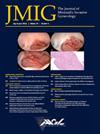腹腔镜技术为跨女性患者进行腹膜拉通阴道成形术
IF 3.5
2区 医学
Q1 OBSTETRICS & GYNECOLOGY
引用次数: 0
摘要
研究目的介绍腹腔镜腹膜牵拉阴道成形术的方法,并回顾其适应症.设计在腹腔镜辅助下进行腹膜牵拉阴道成形术的手术视频和一周的术后随访.设置患者在塞尔维亚贝尔格莱德的贝尔格莱德重建外科中心进行手术。手术需要两名外科医生:一名整形泌尿科医生和一名腹腔镜外科医生。手术期间,患者取背侧截石位。手术需要五个步骤:阴茎分解、腹腔镜腹膜瓣取样、新阴道空间解剖、腹膜拉通和阴道吻合缝合以及腹腔镜新阴道闭合。手术的腹腔镜部分使用了一个 10 毫米的脐上孔插入腹腔镜,外科医生使用了两个 5 毫米的右外侧孔。总手术时间为 5-7 小时。患者术后住院 4-7 天。所有患者均在术后 7 天接受了阴道填料移除和阴道扩张咨询。所有患者都提供了参与手术的书面同意书。干预措施腹膜拉通阴道成形术用于性别肯定手术。所有三名患者术后 7 天的阴道深度均在 14-16 厘米之间。需要更多技术熟练的腹腔镜外科医生参与到性别肯定护理中来,使其更易于使用。本文章由计算机程序翻译,如有差异,请以英文原文为准。
Laparoscopic Technique for Peritoneal Pull-Through Vaginoplasty in the Transfeminine Patients
Study Objective
To present a laparoscopic approach to peritoneal pull-through vaginoplasty and review its indications.
Design
Surgical video and one-week postoperative follow up of peritoneal pull-through vaginoplasty performed with laparoscopic assistance.
Setting
Patients had their surgery at the Belgrade Center for Reconstructive Surgery in Belgrade, Serbia. The procedure required two surgeons: a reconstructive urologist and a laparoscopic surgeon. Patients were positioned in dorsal lithotomy position for the duration of the procedure. The surgery requires 5 steps: penile deconstruction, laparoscopic sampling of peritoneal flaps, dissection of the neovaginal space, peritoneal pull-through and suturing of the vaginal anastomosis and laparoscopic closure of the neovagina. For the laparoscopic part of the surgery, a 10 mm supra umbilical port was used for laparoscope insertion and two 5 mm right lateral ports were used for the surgeon. Total operating time was 5-7 hours. Patients were admitted to hospital for 4-7 days following surgery. All patients were seen 7 days after surgery for vaginal packing removal and vaginal dilation counselling.
Patients or Participants
Three patients appear in the presented surgical photos and videos. All patients provided written consent for their participation.
Interventions
Peritoneal pull-through vaginoplasty for gender affirming surgery.
Measurements and Main Results
All patients had successful surgery with no complications. Vaginal depth at 7 days postoperative varied between 14-16 cm in all three patients.
Conclusion
Peritoneal pull-through vaginoplasty is a viable option for gender-affirming vaginoplasty. Increased involvement of skilled laparoscopic surgeons in gender affirming care is required to make it readily available.
求助全文
通过发布文献求助,成功后即可免费获取论文全文。
去求助
来源期刊
CiteScore
5.00
自引率
7.30%
发文量
272
审稿时长
37 days
期刊介绍:
The Journal of Minimally Invasive Gynecology, formerly titled The Journal of the American Association of Gynecologic Laparoscopists, is an international clinical forum for the exchange and dissemination of ideas, findings and techniques relevant to gynecologic endoscopy and other minimally invasive procedures. The Journal, which presents research, clinical opinions and case reports from the brightest minds in gynecologic surgery, is an authoritative source informing practicing physicians of the latest, cutting-edge developments occurring in this emerging field.

 求助内容:
求助内容: 应助结果提醒方式:
应助结果提醒方式:


